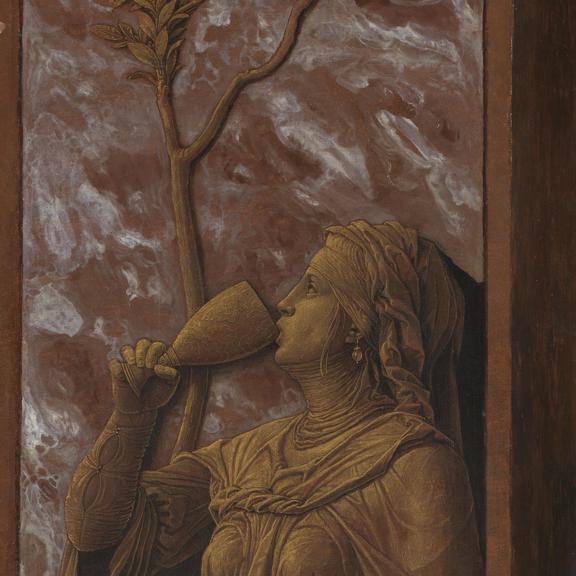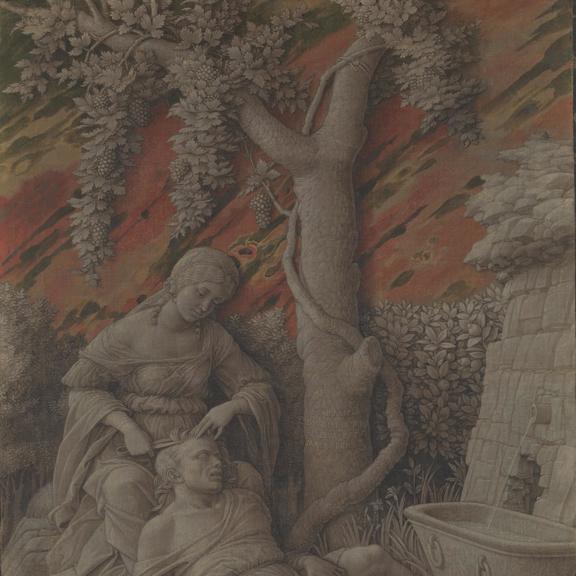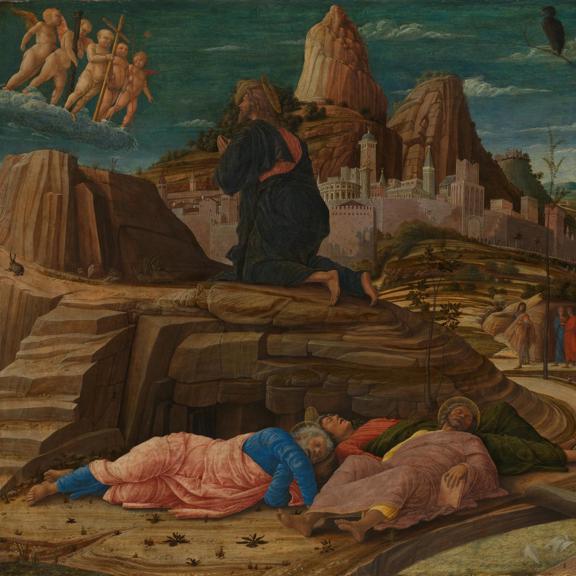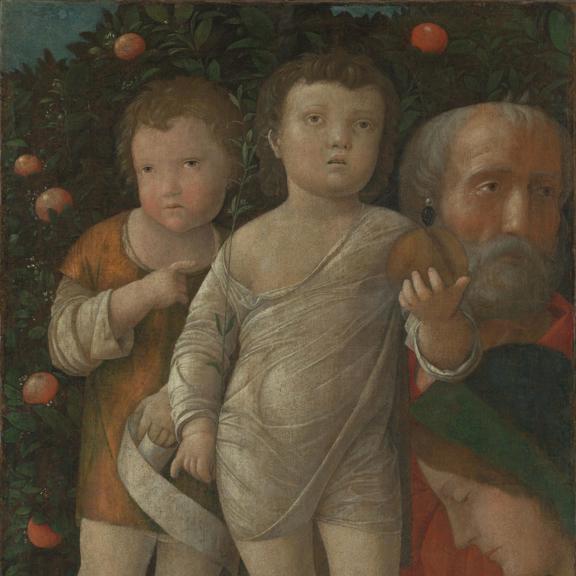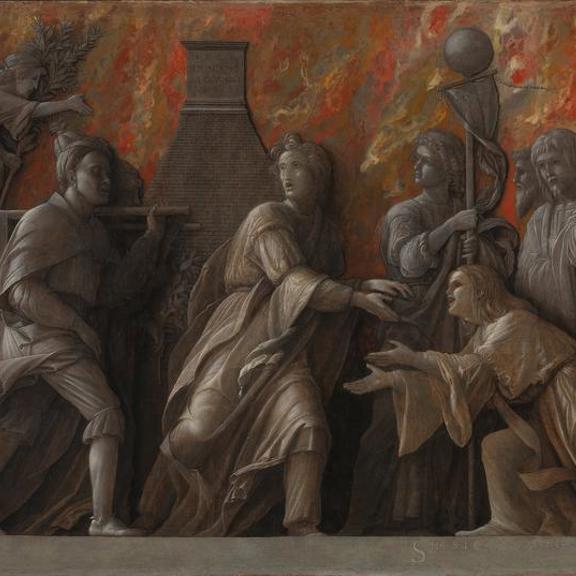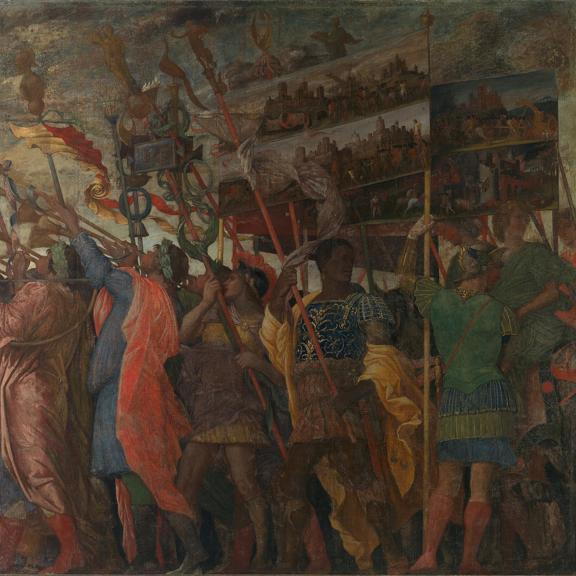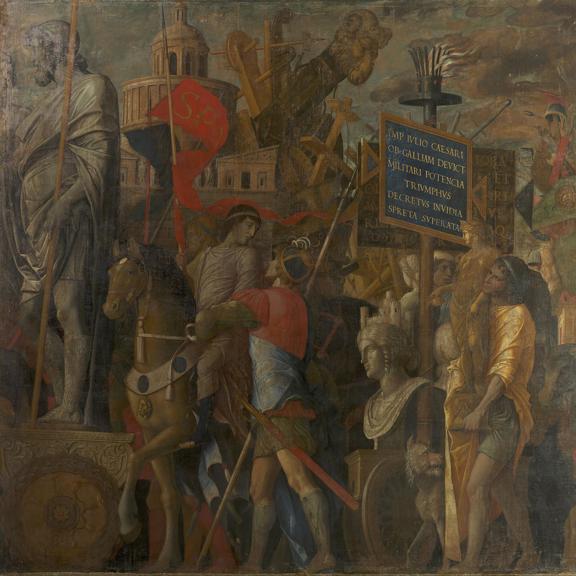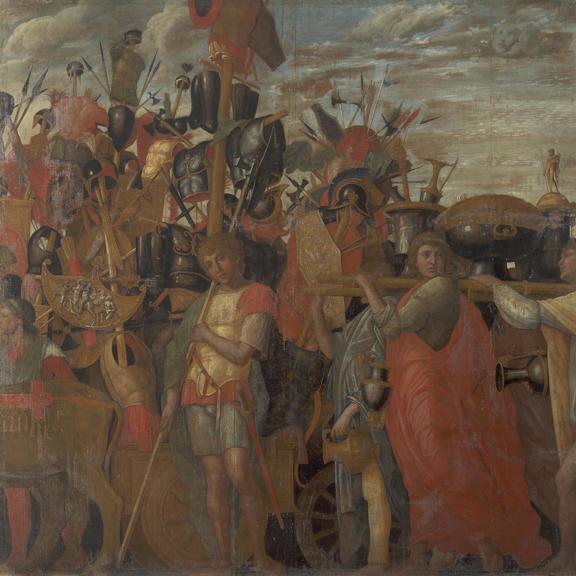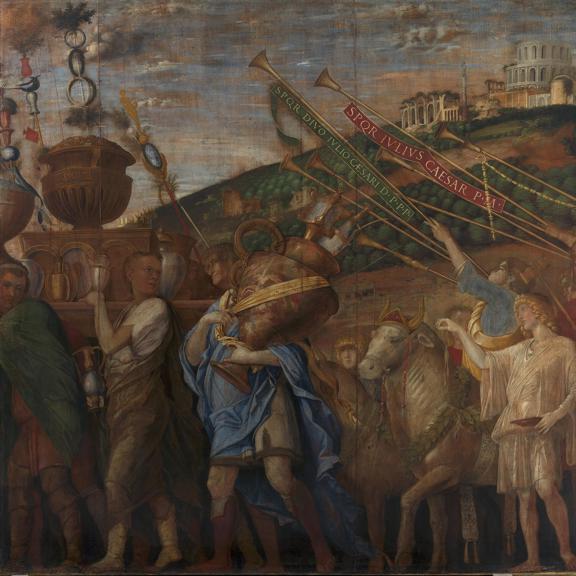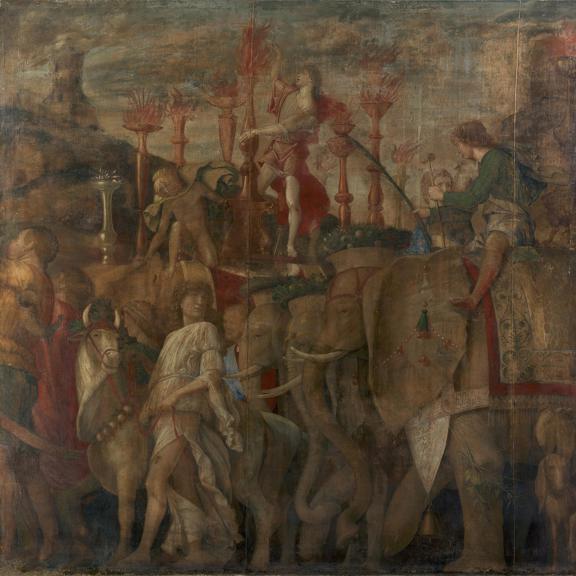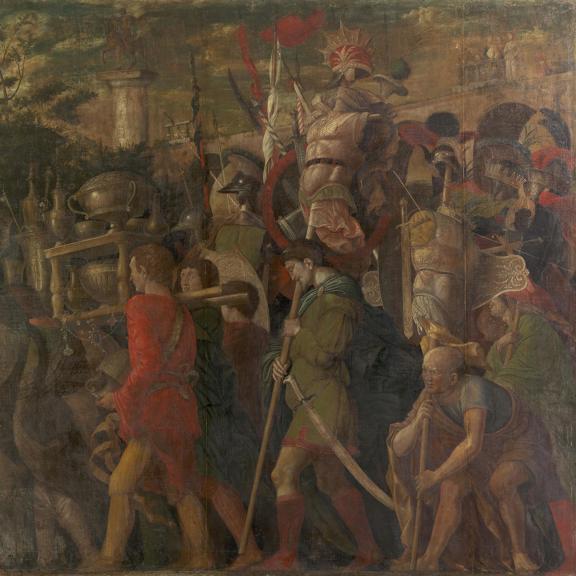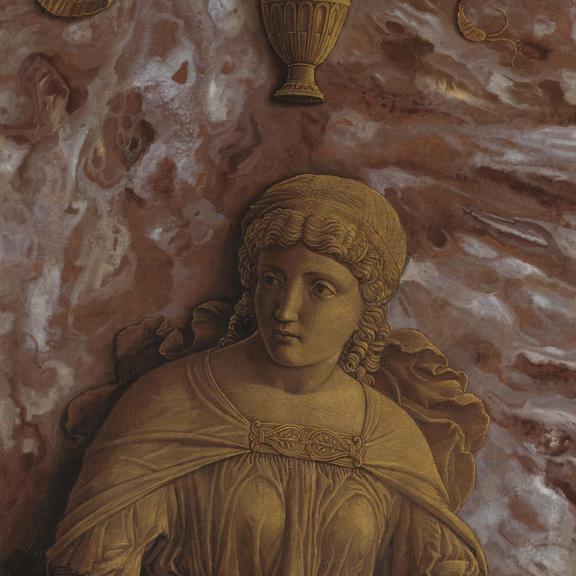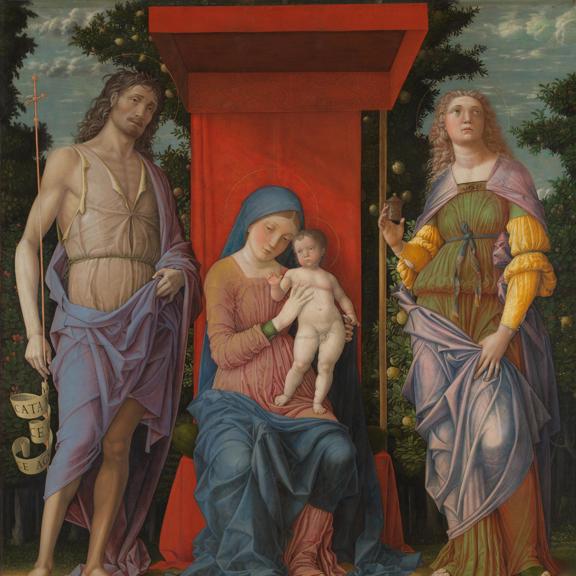Imitator of Andrea Mantegna, The Maries at the Sepulchre
| Full title | The Maries at the Sepulchre |
|---|---|
| Artist | Imitator of Andrea Mantegna |
| Artist dates | about 1431 - 1506 |
| Series | Three Scenes of the Passion of Christ |
| Date made | perhaps 1460-1550 |
| Medium and support | Oil on wood |
| Dimensions | 42.5 × 31.1 cm |
| Acquisition credit | Bequeathed by Lady Taunton, 1892 |
| Inventory number | NG1381 |
| Location | Not on display |
| Collection | Main Collection |
| Previous owners |
Three of Christ’s followers visited his tomb to anoint his body. When they arrived they found ‘a young man... clothed in a long white garment’ who told them that Jesus had risen from the dead (Mark 16: 1–8). In the Gospel of Matthew, the figure is described as the angel of the Lord; the painter of this panel has shown him as an angel with long blue wings. The angel reveals the empty tomb to Mary Magdalene, recognisable by her long flowing red hair, who is taken aback to see that only the burial shroud remains.
The scene is set in a rugged landscape of stony ground and craggy rocks, a characteristic feature of Mantegna’s paintings. Another natural feature often found in paintings by Mantegna is the dead tree. A symbol of death, it is contrasted with the fresh young tree that frames the figure of Mary Magdalene. The living tree symbolises the eternal life that Christ offers through his own death and resurrection.
The Gospel of Mark records that three of Christ’s followers – Mary, Mary Magdalene and Salome – visited his tomb to anoint his body. When they arrived they found that the stone that enclosed the tomb had been rolled away, and that the tomb was empty. Instead they found ‘a young man... clothed in a long white garment’ who told them that Christ had risen from the dead (Mark 16: 1–8). In the Gospel of Matthew, the figure is described as the angel of the Lord; the painter of this panel has shown him as an angel with long blue wings.
The painter of this panel shows the entrance to a cave, which resembles more closely the type of sepulchre described in the Bible, as well as a white marble sarcophagus; with its classical-style carving, this resembles tomb sculpture that Renaissance viewers were familiar with. Mary Magdalene, recognisable by her long flowing red hair, is taken aback by the sight of the empty tomb which the angel reveals to her: only the burial shroud remains. One of the women below has been watching and is now making her way towards the tomb. She wraps her blue robe around her body in shock and, in a flourish that adds drama to the moment, her draperies flick up behind her in the breeze.
The scene is set in a rugged landscape of stony ground and craggy rocks, a ubiquitous feature of Mantegna’s paintings. Another natural feature often found in religious works by Mantegna is the dead tree – here the roots of a gnarled tree stump almost reach into the little pond in the foreground and equally dead branches emerge from the rocky outcrop above the cave. A symbol of death, these roots and branches are contrasted with the fresh young tree that frames the figure of Mary Magdalene. Just as in Noli me Tangere, the living tree symbolises the eternal life that Christ offers through his death and resurrection. It’s worth noting that the stump near the pond has a little fresh branch sprouting from it, perhaps a symbol of hope. Mantegna occasionally also included animals in his works – we find rabbits, for example, in The Agony in the Garden. Here we see a tortoise which has just emerged from the pond, and swimming in it are two ducks.
The sharp folds of the robes of the women and angel, and the characteristic features above, suggest the artist was imitating Mantegna’s style. The soft and blurry edges of the landscape and the hills beyond are less crisp than we would expect from Mantegna and point to a different artist painting at a slightly later date. This painting is from the same series as The Resurrection and Noli me Tangere.
Download a low-resolution copy of this image for personal use.
License and download a high-resolution image for reproductions up to A3 size from the National Gallery Picture Library.
License imageThis image is licensed for non-commercial use under a Creative Commons agreement.
Examples of non-commercial use are:
- Research, private study, or for internal circulation within an educational organisation (such as a school, college or university)
- Non-profit publications, personal websites, blogs, and social media
The image file is 800 pixels on the longest side.
As a charity, we depend upon the generosity of individuals to ensure the collection continues to engage and inspire. Help keep us free by making a donation today.
You must agree to the Creative Commons terms and conditions to download this image.
Three Scenes of the Passion of Christ
These three panels celebrate Christ’s bodily resurrection from the dead. It is likely that all three came from the same series and were painted by the same artist. The pictures reflect aspects of Mantegna’s style, particularly engravings he made at the end of the 1450s and beginning of the 1460s. The jagged rock formations, the angular folds of the draperies and the sinuous figures are particularly characteristic of Mantegna’s paintings.
The painter is unknown but technical analysis of the pigments used shows that they are unlikely to have been painted more than about 50 years after Mantegna’s death. Analysis of the underdrawing (the initial design as drawn on the panel) shows that the painter did not make any alterations to the overall design or any of the details. This suggests that they were tracing directly from a pre-existing image rather than inventing an original composition.
These three panels celebrate Christ’s bodily resurrection from the dead. The first shows the moment at which his tomb was found empty, the second his appearance to Mary Magdalene – both events that are recorded in the Gospels. The third shows him triumphant over death, standing upon his tomb, holding the red and white flag of the Resurrection.
The pictures reflect aspects of Mantegna’s style, particularly engravings made at the end of the 1450s and beginning of the 1460s, and so have been thought to be painted in imitation of his works. The jagged rock formations, the angular folds of the draperies and the slim, elongated limbs of the figures are all characteristic of Mantegna’s paintings. Similarly, certain motifs, such as the soldiers asleep by Christ’s tomb in The Resurrection and the tree encircled by the vine in Noli me Tangere, appear in works by Mantegna himself.
All three came from the same series and were painted by the same artist. There have been various ideas about who the artist might have been – it has been suggested, for example, that it may have been Mantegna’s son, Francesco – but so far they remain unidentified. Technical analysis of the pigments shows that they are unlikely to have been painted more than about 50 years after Mantegna’s death.
Analysis of the underdrawing shows that the painter did not make any alterations to the overall design or any of the details, which suggests that they were tracing directly from a pre-existing image rather than inventing an original composition. They might be copies of images painted by Mantegna for his patrons at the Gonzaga court in Mantua, perhaps for the private chapel there.
Two of the panels came from the Palazzo Capponi in Florence before they were purchased by English collector John Sanford of Corsham Court, Wiltshire. Sanford, who lived in Florence from 1832 to 1837, was one of the most active collectors of Italian painting in the first half of the nineteenth century.
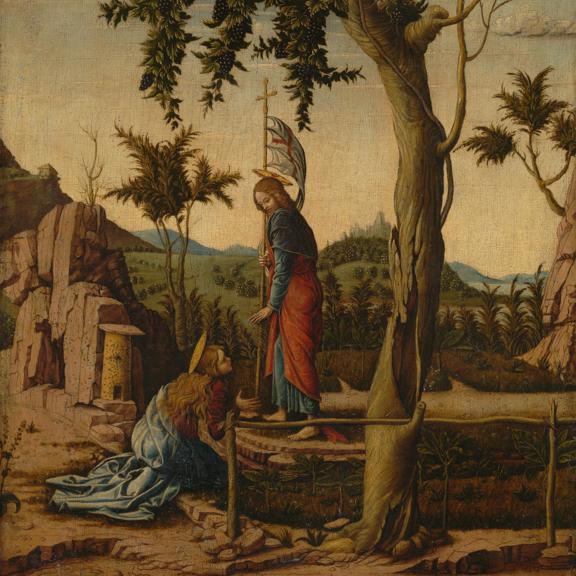
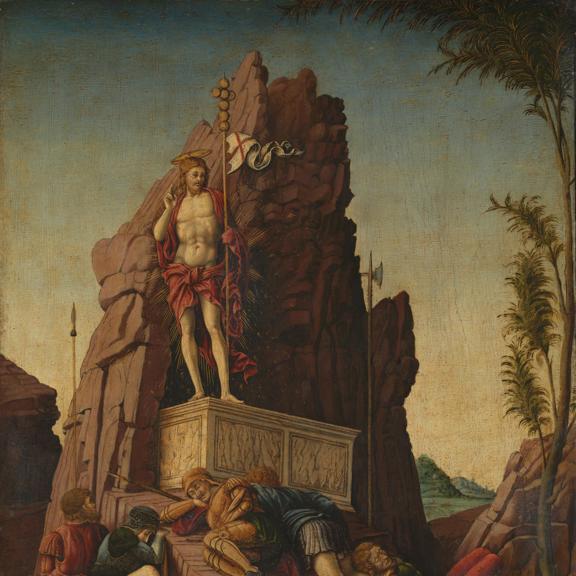
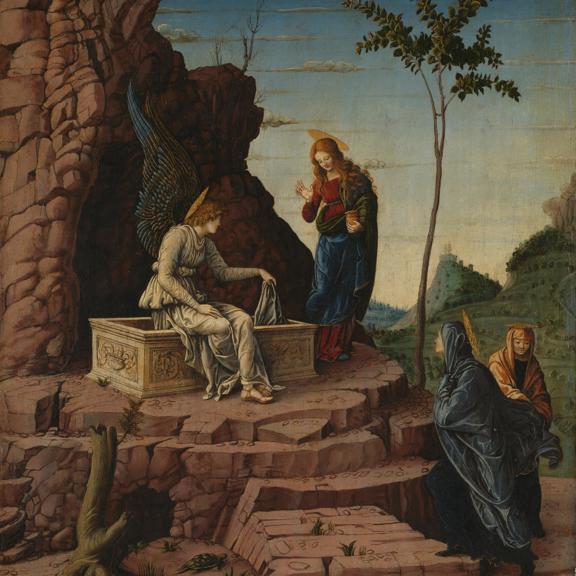
Related paintings
